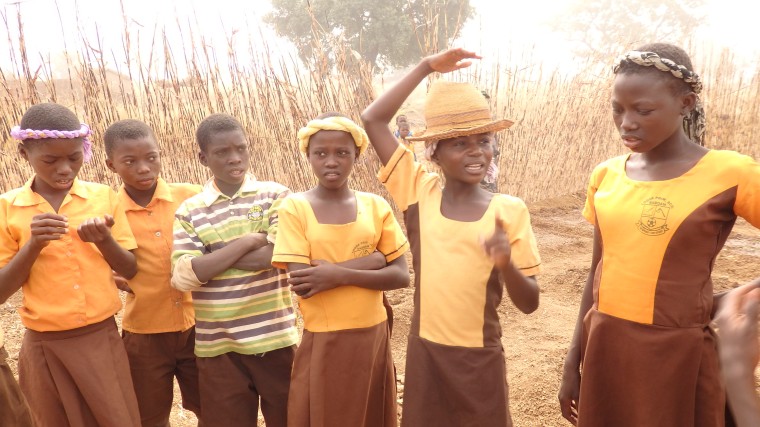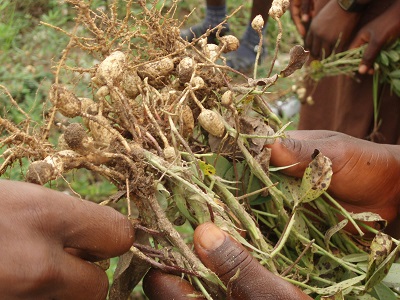Logre Primary School’s headteacher Solomon and Mondo teacher Prosper decided to organize the food project one day before the annual Farmer’s day. This is a public holiday in Ghana and celebrated every first Friday in December, this year on 4th of December.
The tradition of celebrating this day and started in 1986 as a recognition of the important role farmers and fishermen play in the national economy. During that period, agriculture formed about 30%, one third of the country’s GDP. Two consecutive years prior to the first Farmer’s Day celebration, the country had suffered severe drought and wild bush fires, so the agricultural sector needed a boost of moral. So the second purpose the government had was to encourage and motivate the farmers to produce more. (GraphicOnline)

This day is a vacation day for all workers and the whole public sector, a day off to enjoy literally the fruits of their own input. The best farmers and fishermen are nominated for prizes and they receive high recognition. The first best farmer received two machetes, a pair of Wellington boots and a preset radio (GraphicOnline), but nowadays the prizes are bigger and bigger. In 2015 the winner was entitled to a house and also took home a huge sum of money, a laptop and a car (Ghanaweb).
Every year the celebrations take place in a different region and city. This year it was special, because the 31st National Farmers’ Day celebration took place in Upper East region (UER) in Bolgatanga which is the closest bigger city to Kongo village. The theme of 2015 was Transform Ghana – Invest in Agriculture and almost 78 people were honored altogether (Ghanaweb). Bolgatanga is the town where Solomon lives and all Kongo was talking about the big event. The prominent people and elders were all invited to attend the celebrations.
The positive side of having the event carried out in Bolga was that the whole country turned their eyes towards their region. Upper East is the poorest of regions where the nature is the most severe and the famine and lack of education is the most prominent. However this was their occasion to show the hospitality of the locals and their warm hearts and positive assets.
The UER exposed the people of coming in to the agricultural potentials of the region and farmers got well informed about the eco-system, soil types as well as the weather and climatic conditions of the region. The winner of 2015 pointed out the hospitable nature of the people commending them for their religious tolerance. (GraphicOnline) This is one of the aspects one could really feel coming to Bolga, Kongo or Logre site.

The period that Logre organized their food project was already the Harmattan season. The most flourishing rainy season came to end at the end of October, in November the surrounding sites started to dry up. In December it is when the crops really start to lack and the famine sets in.
The Harmattan is a dry, dusty strong wind that blows from the Sahara from December to February. It appears like fog but it is dust and the dust is so dense that it covers the sun. Some people could even describe it as pleasant because the small particles of sand dims down the heat coming from the sun. But for the locals it causes problems from drying the land completely to drying themselves: skins starts cracking and people suffer from occasional and sudden nose bleeds. Shea butter is the best moisturizer for dried skin and lips. (Easytrackgahan) Remind yourself how Sekoti Primary School prepared shea butter last year.
In 2015 the Harmattan started to unusually early.This is one of the consequences of the climate change. The result? The farmers are fearing that the Harmattan could dry up cocoa seedlings but Ghana is one of the two biggest cocoa producers in the world.

So due to Harmattan, it was rather difficult for the school to organize a preparing of the food or show the harvesting. They idea was to show the readers of the foodblog the local culture through some farming songs. The first step is that the group headed to the garden of the PTA chairman Mister Naab Dok. His family was planting pito (vegetable used not only to produce local alcoholic drink but the leaves are also used as vegetable in soups and stews) and tomatoes, even his smallest children were at the site with parents.
The garden was small but lovely, the had used millet sticks to fence it and protect from wild animals. On the way there we could really feel the Harmattan blowing. The headteacher was even about to cancel the event in fear of having bad audio quality and visibility. We still carried the project out in order to honor the preparation work the pupils had done but sorry for any inconvenience the sound may cause. Still, the picture depicts well the seasonal aspects.
The pupils were grouped by their duties, some of them were planting, some carrying water and watering, some accompanied with singing to keep up the good moral and the rhythm. Afterwards the group came together and started dancing to celebrate the end of work.
The headteacher translated the songs sung by the children. They were manly about honoring the works the parents do (the parts of all the participating pupils are farmers). Children need to respect the family and help out with farming activities. Sadly, it often implies skipping school for days do to the planting or the harvesting. Still, having food on the table is the second most important thing to survive after having clean water to drink.
As in the Northern part of Ghana the farming can only been done when the water is present, during the rainy season, parents are looking out for alternative ways of providing for their families. So the often crack stones or go mining gold to earn their living. The translations of the songs and the seasonal aspect of farming is also explained by the headteacher.
Sources used:










